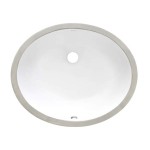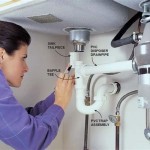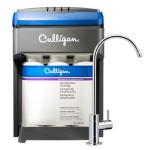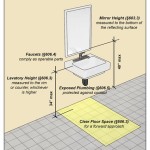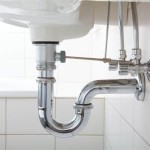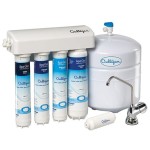How To Disinfect Your Kitchen Sink Without Bleach
The kitchen sink, a seemingly innocuous fixture, is often a significant breeding ground for bacteria and germs. It's where raw meat is prepared, dirty dishes are rinsed, and food scraps accumulate before disposal. This constant exposure to organic matter and moisture creates an ideal environment for microorganisms to thrive. While bleach is a common disinfectant, many individuals seek alternative solutions due to concerns about its harsh chemicals, potential for discoloration, and environmental impact. This article explores several effective methods for disinfecting a kitchen sink without resorting to bleach, providing a comprehensive guide for maintaining a hygienic kitchen environment.
The key to effective disinfection, regardless of the method employed, lies in understanding the principles of sanitation. Disinfection aims to significantly reduce the number of harmful microorganisms to a level where they pose no significant health risk. This differs from sterilization, which eliminates all forms of microbial life. For household purposes, disinfection is generally sufficient to maintain hygiene. Before applying any disinfecting agent, thorough cleaning is essential. This involves removing all visible debris, such as food particles and grease. A clean surface allows the disinfectant to come into direct contact with the microorganisms, maximizing its effectiveness.
Vinegar and Baking Soda: A Powerful Combination
Vinegar, specifically white distilled vinegar, is a readily available and inexpensive natural disinfectant. Its acidity (typically around 5% acetic acid) makes it effective against a range of bacteria and viruses. Baking soda, or sodium bicarbonate, is a mild abrasive that aids in cleaning and deodorizing. The combination of vinegar and baking soda creates a chemical reaction that further enhances their cleaning capabilities.
The procedure involves first rinsing the sink thoroughly to remove any loose debris. Next, sprinkle a generous amount of baking soda over the entire surface of the sink, including the drain. The baking soda will act as a gentle scrubbing agent and help to absorb odors. Once covered, slowly pour white distilled vinegar over the baking soda. A fizzing reaction will occur as the vinegar and baking soda react, releasing carbon dioxide. This effervescent action helps to loosen grime and dislodge stuck-on food particles.
Allow the mixture to sit in the sink for approximately 10-15 minutes, allowing the vinegar to disinfect and the baking soda to scrub away dirt. After the waiting period, use a sponge or scrub brush to thoroughly scrub the entire sink surface, paying particular attention to areas around the drain and faucet. Rinse the sink with hot water to remove any remaining residue of vinegar and baking soda. For stubborn stains or heavily soiled areas, repeat the process or use a more abrasive scrubbing pad.
The vinegar and baking soda method is particularly effective at removing hard water stains and soap scum, which can harbor bacteria and mold. Vinegar's acidic properties also make it a good choice for disinfecting garbage disposal units. Pouring a cup of vinegar down the drain and allowing it to sit for 30 minutes can help to eliminate odors and kill bacteria lingering in the disposal.
While vinegar is a potent disinfectant, it's important to note that it is not effective against all types of microorganisms. For example, it may not be as effective against certain viruses or fungi as bleach. However, for routine cleaning and disinfection, vinegar provides a safe and effective alternative to harsh chemicals.
Hydrogen Peroxide: A Versatile Disinfectant
Hydrogen peroxide is another readily available and effective disinfectant. It is a colorless liquid that breaks down into water and oxygen, making it an environmentally friendly option. Hydrogen peroxide is a powerful oxidizing agent, meaning it works by disrupting the cellular structure of microorganisms, thereby killing them. A 3% solution of hydrogen peroxide, commonly found in pharmacies, is sufficient for disinfecting surfaces in the kitchen.
Before applying hydrogen peroxide, the sink should be thoroughly cleaned of any visible debris. Once cleaned, spray the entire surface of the sink with the 3% hydrogen peroxide solution. Ensure that all areas, including the drain, faucet, and corners, are adequately coated. Allow the hydrogen peroxide to sit on the surface for at least 10 minutes to allow sufficient contact time for disinfection. The longer it sits, the more effective it will be in killing bacteria and viruses.
After the waiting period, rinse the sink thoroughly with water. Hydrogen peroxide is generally safe for use on most sink materials, including stainless steel, porcelain, and composite sinks. However, it is always recommended to test a small, inconspicuous area first to ensure that it does not cause any discoloration or damage. For heavily soiled areas, consider using a stronger solution of hydrogen peroxide, but exercise caution and always wear gloves to protect your skin.
Hydrogen peroxide is particularly effective against bacteria, viruses, and fungi. It is also a good choice for disinfecting cutting boards and other kitchen utensils that come into contact with raw meat. To disinfect a cutting board, simply spray it with hydrogen peroxide and allow it to sit for 5-10 minutes before rinsing with water. However, do not mix hydrogen peroxide with vinegar, as this can create peracetic acid, which can be irritating to the respiratory system and skin.
One of the advantages of using hydrogen peroxide is that it is odorless and leaves no residue. This makes it a good choice for individuals who are sensitive to strong smells or who prefer a more natural cleaning solution. It's also relatively inexpensive and readily available at most pharmacies and grocery stores.
Boiling Water: Simple and Effective
Boiling water is a simple yet effective method of disinfection, particularly for drains and garbage disposals. The high temperature of boiling water is sufficient to kill many types of bacteria and viruses. This method is especially useful for disinfecting areas that are difficult to reach with other cleaning agents, such as the inside of a drainpipe.
To disinfect the sink drain with boiling water, first ensure that the sink is empty and that the drain is free of any large debris. Then, carefully pour a kettle or pot of boiling water down the drain. The hot water will help to flush away any lingering bacteria and food particles. Exercise caution when pouring boiling water to avoid scalding yourself or damaging the sink or surrounding surfaces.
For garbage disposals, boiling water can help to break down grease and food particles that may be clinging to the blades. Pouring boiling water down the disposal while it is running can help to dislodge these particles and prevent odors. However, it's essential to consult the manufacturer's instructions for the garbage disposal before using boiling water, as some models may not be able to withstand the high temperature.
While boiling water is effective at killing many microorganisms, it may not be sufficient to eliminate all types of bacteria and viruses. For example, some bacteria can form spores that are resistant to high temperatures. Therefore, boiling water should be used in conjunction with other cleaning and disinfection methods for optimal hygiene.
Boiling water is a safe and environmentally friendly option for disinfecting drains and garbage disposals. It is also a quick and easy way to remove grease and food particles, helping to prevent clogs and unpleasant odors. However, it is important to exercise caution when handling boiling water to avoid burns.
In addition to these methods, ensuring proper ventilation in the kitchen is crucial for preventing the growth of mold and bacteria. Regularly cleaning and disinfecting sponges and dishcloths is also essential, as these items can easily harbor microorganisms. Regularly cleaning the sink and employing these alternative methods to bleach can help maintain a hygienic kitchen environment.

How To Disinfect Your Sink In 2 Steps Without Bleach

How To Clean Porcelain Sinks Without Bleach Simplify Live Love

How To Naturally Kill Germs In A Kitchen Sink Get Green Be Well

How To Clean A Kitchen Sink Of Any Type 5 Steps Deep Your Trusted Since 1922

How To Disinfect Your Kitchen Sink With Hydrogen Peroxide

How To Clean Porcelain Sinks Without Bleach Simplify Live Love

How To Clean Your Kitchen Sink Disposal Naturally With Baking Soda Vinegar Easy Organic Youtube
How To Disinfect Your Kitchen Sink Without Bleach According An Expert

How To Clean A Kitchen Sink Home Repair Tutor

The Easiest Way To Clean A White Kitchen Sink And Keep It Sparkling
